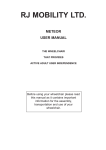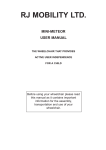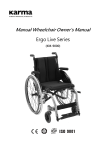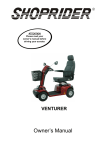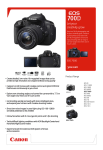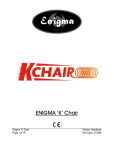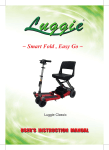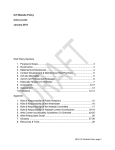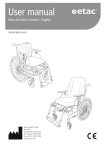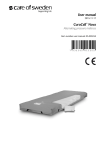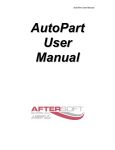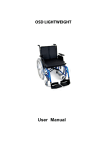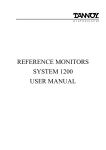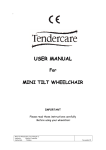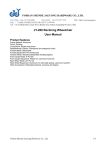Download Maxi Ultra (user)
Transcript
RJ MOBILITY LTD. MAXI SELF PROPELLING USER MANUAL THE WHEELCHAIR FOR THE LARGER USER Before using your wheelchair please read this manual as it contains important information for the assembly, transportation and use of your wheelchair. Thank you for choosing a Maxi wheelchair. We hope that it will provide many enjoyable years of reliable service and fulfil all your mobility needs. This user manual should be read carefully before you use your Maxi wheelchair. This user manual contains important information regarding the safe operation and maintenance of your Maxi wheelchair. Please make sure that you understand all the instructions thoroughly. If you fail to understand anything or have any questions concerning operation and maintenance, please contact your supplier who will provide you with expert professional advice. R J Mobility Limited is a quality approved manufacturer to BS5750 Part 2/ISO 9002. This product is manufactured to comply with the essential requirements of the Medical Devices Directive 93/42 EEC. In line with our policy of continuous improvement we welcome any suggestions that could lead to product improvement. -1- CONTENTS Item 1 2 3 4 5 6 7 8 9 10 11 12 13 14 15 16-21 22 23 24 25 Page INTRODUCTION USER CATEGORIES PARTS IDENTIFICATION UNFOLDING AND PREPARING FOR USE FOLDING FOR STORAGE OR TRAVEL ATTENDANT PUSHING GETTING IN AND OUT OF YOUR WHEELCHAIR GETTING IN FROM THE FRONT GETTING OUT FROM THE FRONT SIDE TRANSFER TO A WHEELCHAIR SIDE TRANSFER FROM A WHEELCHAIR USING YOUR WHEELCHAIR : DO'S AND DON'TS ASCENDING AND DESCENDING SLOPES ASCENDING AND DESCENDING KERBS UNEVEN, SLIPPERY AND SOFT SURFACES CARE AND MAINTENANCE FACTORY FITTED OPTIONS ACCESSORIES SERVICE HISTORY WARRANTY -2- MAXIUSB. 1. INTRODUCTION Your MAXI WHEELCHAIR is intended for everyday indoor and outdoor use. They are designed to transport one person up to 178Kg (28 stone) in weight and this total weight should note exceeded. The self-propelling model is primarily for use and control by the occupant. It has 61cm (24") diameter rear wheels fitted with pneumatic or puncture proof tyres and hand rims for user self-propulsion; push-handles are provided for attendant assistance. Each wheelchair is painted in a durable powder coated colour finish. Seating and backrest materials are vinyl-coated and flame retardant. 1.1 WHEELCHAIR TRANSPORTATION IN MOTOR VEHICLES All of the wheelchairs in our range are designed to be easily transported and most of them dismantle into manageable parts in seconds. Consideration should be given to the type of vehicle in which the wheelchair may be carried. A small car with a heavy power chair in the boot may be affected in the way in which it steers or brakes, so care should be taken to distribute the load sensibly. It should also be noted that even a lightweight manual wheelchair has considerable mass in the event of emergency braking and some form of restraint is essential when transporting any wheelchair in any vehicle. It is strongly recommended that the user transfers to a vehicle seat and the wheelchair is transported separately. However, if this is not possible and the user intends to travel in a moving vehicle whilst seated in the wheelchair, it is essential they follow clear safety guidelines and understand that this is not as safe as using the vehicle seat. Many of our wheelchairs have been shown to withstand simulated crash conditions without injury to the user. We have compiled a separate document describing the conditions in which these tests were carried out and clearly detailing the manner in which the wheelchair should be restrained. Any wheelchair restraints must be separate to the user restraints. It is the responsibility of the transport operator and the wheelchair user to ensure that safety measures taken are suitable for both the wheelchair user and other passengers. All passengers in motor vehicles accept that risk is involved in travel but this is compounded by wheelchair use. The wheelchair brakes are not designed to withstand forces such as cornering, acceleration and braking within a motor vehicle, therefore additional special restraints must be provided. The wheelchair should be secured to the vehicle floor in-line with the direction of travel. The occupant should be separately restrained to the vehicle and NOT to the wheelchair. Installers and operators of restraint systems should be trained in their correct use by the restraint manufacturer, or approved specialist. Additional fittings such as trays should be removed and stowed separately. It is recommended that wheelchairs with a full height backrest are used. -3- R J Mobility have undertaken crash testing to latest known international standard test methods and recommend the use of the Unwin 4 - Point Tie Down system. The following wheelchairs have been tested and we have published details which are available upon request. Barrett 7H Barrett 10H Meteor (additional back support is recommended) Mini-Meteor Independent Other products in our range and R J Mobility products manufactured prior to testing have been used to transport users in motor vehicles over many years without serious incident and it must be decided by the user/carer whether to continue to do so. It is not as safe as travelling in a vehicle seat and there are risks involved. These are minimised with the use of effective recommended equipment/restraints and our company believes in freedom of choice for informed individuals so please be aware of the risks and make your own informed choice. To obtain free written details of the tests we have carried out, please write to: RJ Mobility Limited Boy Lane Wheatley Halifax HX3 5AF England 2. USER CATEGORIES FOR THE MAXI SELF-PROPELLING WHEELCHAIR A1 Occupant with all limbs intact and having the ability to co-ordinate both arms and hands with sufficient strength to self-propel and control the wheelchair safely and maintain an upright seating position. A1/2 Lower limb, single or double amputees or users of greater than average upper body mass or unusual weight distribution will require an increased wheel base to maintain stability (this is a factory made option and cannot be retrofitted). IMPORTANT The above identifies the minimum user characteristics suitable for the Maxi attendant-controlled or self-propelled wheelchair. -4- 3. WHEELCHAIR PARTS IDENTIFICATION FOR MAXI WHEELCHAIR Once the packaging has been removed, check for missing parts against the diagram below and inspect for damage to the more fragile parts such as: handrims, spokes, seat and back upholstery and footrest assembly. There should be nothing bent or broken. (14) PUSH HANDLE (1) HEIGHT ADJUSTABLE ARMREST (DETACHABLE) (13) FOLDING BACKREST (2) ARMREST HEIGHT ADJUSTER (12) BACKREST RELEASE KNOB (11) BRAKE LEVER (3) ARMREST RELEASE LEVER (4) FOOTREST ASSEMBLY (10) REAR WHEEL (5) FOOTPLATE HEIGHT ADJUSTER CLAMP (9) HANDRIM (6) FOOTPLATE ANGLE ADJUSTER NUT (8) TIPPING LEVER (7) FRONT CASTOR Please contact your supplier immediately if the wheelchair is not to your satisfaction. -5- 4. UNFOLDING AND PREPARING THE MAXI WHEELCHAIR FOR USE It may be advisable to have the wheelchair prepared for use for the first time by an able bodied assistant. Until the folding components have lost some of their stiffness, the wheelchair may require moderate strength and effort to assemble it properly. The wheelchair needs to be placed on a level non-slip surface and the brakes applied by moving the lever forwards. Armrests should be placed to one side. No tools are necessary for the assembly of your wheelchair and the procedure is as follows. 1 Standing behind the wheelchair lift the push handles to a vertical position (see FIG 1). Figure 1 2 Slide the backrest release knobs (A) downwards on each side of the backrest (see FIG 2). A Figure 2 3 Stand at one side of the folded Maxi wheelchair. Tilt it slightly to balance on one rear wheel and simultaneously press down on the opposite side of the seat and push until the wheelchair is fully open. Check that the seat tubes (A) have located in their cradles (B) (see FIG 3). In order to prevent the seat tubes not locating, support clips are provided (see FIG 3a). To locate these simply latch the hook over the seat tube and lock the mechanism by pushing of the cam. -6- PRESS DOWN A B Figure 3 Figure 3a With the chair unfolded, place the support bar hooks (A) over the push handles, and tighten the clamp handles on each side, securing the support bar in place. A IMPORTANT Ensure your fingers are kept above the level of the seat to prevent trapping them between the seat tube and the wheelchair frame. B 4 Rotate the footrest assembly (A) forwards on the hinge pins (B) until the locking catch (C) locks the footrest assembly into position. Footplates (D) can be lowered when sitting in the wheelchair (see FIG 4). A D C Figure 4 5 Each armrest is height adjustable. Rotate the armrest release lever (A) upwards and lift the armrest assembly (B) from the wheelchair frame socket (C). To select the optimum armrest height remove the height adjustment screw (D) and locate in one of the five threaded positions. Replace armrest assembly (B) in the wheelchair frame socket (C) and rotate the armrest release lever (A) downwards (See FIG 5). Ensure that the RJ Logo faces outwards. B D C A Figure 5 IMPORTANT Check the security of the armrest by lifting upwards with the armrest lock lever in a right angle position. It should not be possible to remove the armrest assembly from the wheelchair frame socket. Keep fingers away from the frame socket to avoid trapping fingers. -7- 5. FOLDING THE MAXI WHEELCHAIR FOR STORAGE OR TRAVEL 1 C Flip up the footplates (A), press locking catch (B) outwards and rotate the footrest assembly (C) rearwards (see FIG 1). B A 2 Pull out the transit pin (A) from the lower hinge pin if you require to remove the footrest assembly (see FIG 2). Figure 1 A Figure 2 3 Lift the footrest assembly upwards to remove (see FIG 3). Figure 3 B 4 C A Rotate the armrest release levers (A) upwards and lift the armrests (B) directly upwards and remove them from their sockets (C) (see FIG 4). Figure 4 -8- 5 Standing behind the wheelchair, slide the backrest release knobs (A) upwards which will enable the backrest to fold downwards (see FIG 5). A Figure 5 6 Standing to the side of the wheelchair place each hand under the front and back of the seat fabric. Lift upwards to ensure the wheelchair fully folds (see FIG 6). Figure 6 -9- 6. ATTENDANT PUSHING IMPORTANT It should be noted that the combined weight of the wheelchair and user can be quite considerable, so take great care when tipping backwards. Attendants/assistants will require enough physical strength and agility to safely assist the user when getting in and out of the wheelchair. Where possible, adequate space should be allowed as physical exertion in confined spaces can lead to strains and injury to both the user and attendant. Attendants in control should be mentally mature and responsible. Attendants should not apply the brake by using the foot as this could lead to breakage. The wheelchair occupant should be made comfortable by the attendant who should: a. Not walk too quickly when pushing the wheelchair. b. Make all moves slow and deliberate informing the occupant when he or she intends changing direction, preferably before the manoeuvre is commenced. Tipping the wheelchair or changing speed can cause occupant distress. c. Pay attention to the road surface, avoiding uneven or soft ground. d. When at a halt ensure that the occupant can see and communicate. e. Take great care when ascending and descending slopes as the force to stop the chair will be greatly increased. It is safer to avoid kerbs wherever possible and use ramped kerbs or slopes. If this cannot be avoided, then adopt the procedures in Section 15. -10- 7. GETTING IN AND OUT OF YOUR WHEELCHAIR IMPORTANT Do not stand on the foot plates. Do not lean on one armrest only. Do take extra care on slippery/uneven surfaces and slopes. Do remove any unnecessary obstructions. Do apply the brakes. There is a risk of the wheelchair tipping if you are too far forward on the seat. If you have not attempted these movements before, or your medical condition does not allow you to support your body weight comfortably, it is advised that an able bodied person be in attendance to help and assist. 8. GETTING IN THE WHEELCHAIR FROM THE FRONT 1 Apply the brakes. 2 Flip up the footplates and/or swing the footrest assembly to the side. 3 Stand close to the front edge of the seat with your back to the wheelchair and, with one hand on each armrest, lower yourself into the wheelchair. Swing the footrest assemblies back to the front, lower the footplates and place your feet on them engaging your heels in the heel loops provided. Beware of catching your ankles or lower legs as you swing the footrests into position. -11- 9. GETTING OUT OF YOUR WHEELCHAIR FROM THE FRONT TO A STANDING POSITION 1 Apply the brakes. 2 Flip up the footplates and/or swing the footrest assembly to the side. 3 Move forward on the seat, and with one hand on each armrest, bend slightly forward to bring the body weight to the front of the seat. With both feet firmly on the ground and one foot well back, push into the upright position. 10. SIDE TRANSFER TO A WHEELCHAIR NOTE: This can only be done comfortably from a seating position that is at the same level and from a seat that does not have side arms which may obstruct movement. 1 Flip up the footplates and swing the footrest assembly to the side. 2 Place the side of the wheelchair up against the seat you are on and apply the brakes. If an assistant is available, ask them to steady the wheelchair to prevent any movement that may take place. 3 Remove the armrest nearest to you, so that you can slide sideways without obstruction. Beware of the upholstery securing screws during the transfer process. You may find the use of a "transfer board" helpful. 4 When you are ready, reach out and place one hand on the seat as far away from you as you can reach and push downwards and sideways, transferring your weight from your seat to the wheelchair. When you are comfortable, replace the armrest ensuring that it is locked securely. 5 Swing the footrests into position. Beware of catching your ankles or lower leg as you swing them into position. Fold down the footplates and place your feet on them, locating your heels in the heel loops provided. -12- 11. SIDE TRANSFER FROM A WHEELCHAIR NOTE: This can only be done comfortably from a seating position that is at the same level and from a seat that does not have side arms which may obstruct movement. 1 Flip up the footplates and swing the footrest assembly to the side. 2 Place the side of the wheelchair up against the seat you want to sit on and apply the brakes. If an assistant is available, ask them to steady the wheelchair to prevent any movement that may take place. 3 Remove the armrest on the side you want to move towards and place your hand on the seat rail by the remaining armrest. You may find the use of a "transfer board" helpful. 4 Place the other hand on the seat or surface that you are transferring to, ensuring it is stable. 5 Move forwards in the wheelchair and, leaning slightly forwards, push upwards and slide sideways. -13- 12. USING YOUR WHEELCHAIR : DO'S AND DON'TS Moving forward and backward is achieved by grasping both handrims and rotating in the required direction. Turning left and right is achieved by holding the wheel stationary in the direction of travel whilst rotating the opposite wheel in the forward motion. Braking of the wheelchair can be achieved by gripping the handrims to slow rotation. Be aware that high speeds may cause friction burns. Gloves may be advisable. DO take care negotiating inclines, uneven, soft or slippery surfaces, as the risk of tipping over is increased. DO be aware that unless slopes are negotiated carefully the chair could be difficult to control. DO be aware of the surface temperature of all the wheelchair parts in hot and cold weather. DO be aware that erratic control can cause injury to the user and other people. DO be aware that effectiveness of the brakes may be reduced if the tyres are wet, muddy or greasy. DO observe the Highway Code. DO avoid soft ground. DO keep clothes, rugs, covers etc. clear of the wheels. DO fit a waist safety belt for additional security. DO be aware that most pavements slope slightly towards the kerb and the wheelchair may tend to pull towards the road. DO use two hands for pushing. DO ensure that the wheelchair is hygienically clean and suitable for multi-user use, if applicable. DO NOT insert fingers in the spokes. Spoke guards are available as a low-cost option. DO NOT use the wheelchair without footplates, as feet may become trapped underneath. DO NOT use the wheelchair without armests fitted, as you may fall out, or catch clothing in the wheels. DO NOT use the wheelchair if the tyres are not inflated to the correct pressure as this may render the brakes ineffective. DO NOT turn quickly as this may cause the wheelchair to tip. DO NOT carry heavy objects/passengers, as this may lead to instability. DO NOT lift the wheelchair using the armrests or footrests - always use the main frame. DO NOT trap fingers between the brake pad and the tyre. DO NOT use the wheelchair while under the influence of drugs or alcohol. DO NOT force the wheelchair forward if it becomes stuck. DO NOT stand on the footplates of the wheelchair under any circumstances. -14- 13. ASCENDING AND DESCENDING SLOPES SAFELY IMPORTANT Movement of the occupant could cause the wheelchair to tip on a slope. MAXIMUM SLOPE ANGLE 10° The Maxi wheelchair remains stable when ascending a slope of up to 10o. Beware if you feel the wheelchair becoming unstable, do not proceed. When descending, a slow speed should be maintained by gripping the handrims firmly. Excessive speed could cause friction burns on the hands. On steep slopes, care should be taken not to slip out of the wheelchair. Wherever possible, an attendant should provide assistance by pushing (if ascending) or restraining (if descending) whilst the occupant controls the wheels. Attendants should have sufficient strength to control the wheelchair and occupant when negotiating inclines, kerbs or steps. -15- 14. ASCENDING AND DESCENDING KERBS It is safer to avoid kerbs wherever possible and use ramped kerbs or slopes. If this cannot be avoided, then adopt the following procedures. It is possible to take yourself up and down kerbs unaided. If you feel you would be able to do this, do not try it until you have had proper instruction and practice. Ask your therapist or an experienced wheelchair user for help. IMPORTANT Movement of the occupant could cause the wheelchair to tip on kerbs and steps. By placing the rear wheel of the Maxi wheelchair against the kerb, if ascending, or at the edge of the kerb if descending, the occupant can ascend/descend small drop kerbs independently. However, wherever possible, an attendant should provide assistance by pushing if ascending (or restraining if descending) whilst the occupant controls the wheels and brake operation. GOING UP A KERB FORWARDS 1 Make sure the occupant's feet are on the footplates and will not slip off. 2 Release both brakes. 3 Place both hands firmly on the push handles. Make sure the handgrips are secure and cannot be pulled off. 4 Put one foot on the tipping lever at the back of the wheelchair (see diagrams below). Tell the wheelchair occupant you are about to tilt backwards. 5 Pull back with both hands and push down and forwards with the foot. This will bring the wheelchair onto the back wheels. If it is tilted too far back, it will be heavy to hold and the person in the wheelchair will feel unsafe. Do not let the castors rise more than 4" (10cm) off the ground. 6 Push the wheelchair forwards, gently lower the front castors on to the pavement, and push the back wheels upwards over the kerb. 1 2 -16- 3 GOING UP A KERB BACKWARDS IMPORTANT This is a difficult method, requiring more strength and should only be attempted with a light person in the wheelchair. 1 Turn the wheelchair around so that the back wheels are resting against the kerb. 2 Pull back on the push handles and push downwards to tilt the wheelchair so that the front castors are off the ground. The proximity of the kerb will prevent the use of the tipping levers as previously described. 3 Pull the tilted wheelchair up the kerb and on to the pavement. 4 Continue pulling until the castors are over the pavement. Gently lower the castors to the ground. 3 2 -17- 1 GOING DOWN A KERB BACKWARDS This is the easiest and smoothest method and is the reverse sequence to that described in GOING UP A KERB FORWARDS. As it requires the attendant to step off the kerb backwards into the road exercise extreme caution. 1 Back the wheelchair to the edge of the kerb. 2 Use the push handles to pull the rear wheels down onto the road. 3 Tilt the wheelchair backwards as previously described and pull the tilted wheelchair further into the road. 4 When the footrests are clear of the kerb, lower the front castors on to the road. 2 3 -18- 1 GOING DOWN A KERB FORWARDS This method has the advantage that you can see the traffic more easily. The disadvantages are that it is harder physical work and it is not easy to lower the wheelchair gently without jarring the person in the wheelchair. 1 Position the wheelchair so that the front castors are close to the edge of the kerb and check that the road is clear. 2 Pull back on the push handles, gripping them firmly, and at the same time push downwards and forwards with the foot on the tipping lever to balance the wheelchair on its back wheels. 3 The person in the wheelchair may be able to help by using the handrims to steady the wheelchair. 4 Move the wheelchair forwards and then gently lower the rear wheels down the kerb while supporting some of the wheelchair's weight yourself. Make sure that both wheels touch the ground at the same time because if not the wheelchair could tip over sideways. 5 Gently lower the front castors. 6 Check that the road is still clear before moving off. IMPORTANT Never tip the wheelchair forwards when going down a kerb. The person in the wheelchair might fall out. 1 2 3 15. UNEVEN, SLIPPERY AND SOFT SURFACES Care should be taken at all times. Maintain a slow speed, so that you can keep control. Note that grass may be soft and the wheels may sink, causing the wheelchair to tip. Any moisture or mud on the tyres may affect the proper operation of the parking brakes. -19- 16. CARE AND MAINTENANCE OF YOUR MAXI WHEELCHAIR Your Maxi wheelchair should require very little maintenance when used with care and discretion and will retain its appearance if looked after and cleaned in accordance with the following instructions. Protection of your wheelchair during shipment or travel is dependent upon the type of journey envisaged, but attention should be given to protecting the more fragile items. 17. TYRE PRESSURE IMPORTANT Under no circumstances should garage powered airlines be used. If your wheelchair is fitted with pneumatic tyres, a hand pump is provided. Tyres are best inflated by an assistant with a car type foot pump up to the recommended pressure of 50psi/340 Kilopascals (KPA). This pressure is also displayed on the wall of the tyre. Pressures should be checked weekly, using a proprietary pressure gauge and a daily visual check made of the tyre condition. Things to look for are nails, sharp objects, etc. stuck in the tyre tread, splits, cracks or abrasions to the tyre wall, and a deflated tyre (this would indicate a puncture or leaking valve). Excessively worn or damaged tyres should be replaced without delay. If the tyre does become deflated, or need replacing, contact your wheelchair supplier for assistance. IMPORTANT Brakes may not work if tyres are under-inflated. 18. CLEANING The upholstery may be cleaned with warm water and mild soap. Never use a solvent of any type to clean your wheelchair. The paintwork may be cleaned or polished with a car type polish. Wipe off any moisture after outdoor use and store your wheelchair in cool and dry conditions. -20- 19. LUBRICATION The wheels and castors on your wheelchair do not need any additional lubrication. A few drops of general purpose oil can occasionally be added to pivot points on folding parts and brakes. Wipe away any excess oil to prevent dirt collection. If the optional quick release wheel is fitted, it is essential that the quick release axle bush is kept lightly lubricated at all times to ensure ease of action. It is recommended that a silicon based lubricant is used for this application or a water displacing lubricant, eg WD40. 20. MAINTENANCE SCHEDULE IMPORTANT It is advisable that professional servicing is carried out at six monthly intervals for a wheelchair in constant daily use. For a wheelchair exposed to less usage, the weekly checks should be carried out every time the wheelchair is used. DAILY CHECK: Handrim damage and security. Hand grips for secure attachment. Loose or bent spokes. Brake operation. Folding mechanism. WEEKLY CHECK: Seat and backrest upholstery/cushions for tears or damage. Push handles for security. Wheel and castor security. Cross brace folding mechanism. Check that the pivot bolts are not loose. Tyre pressure and condition. Armpad condition and security to armrest frame. -21- 21. GENERAL CHECKS TO BE CARRIED OUT AT MONTHLY INTERVALS IMPORTANT If any of the items listed below give cause for concern, consult your wheelchair supplier immediately. Do not overtighten upholstery screws as this can damage the upholstery. It is advisable that professional servicing is carried out at six monthly intervals for a wheelchair in constant daily use. 1 Open the wheelchair. All movements should be free throughout the folding range and should not bind or seize whilst operating. 2 All pivot bolts should be secure with no sign of nuts or bolts working loose, but they must be free enough to allow the component parts to move whilst operating. 3 Examine the seat and backrest upholstery for wear or damage. Examine the retaining screws for tightness. Any that are protruding or loose should be tightened with a Pozidrive (cross point) screwdriver. 4 Examine the brakes for wear, damage or misalignment. Ensure that both brakes prevent the rear wheels turning, when fully applied and the tyres are inflated to the correct pressure. If not, refer to your wheelchair supplier for adjustment. 5 Check the castors for free rotation of the castor wheel and swivel assembly. Look for looseness or binding. 6 Check the rear wheels for free and easy rotation. Check the rims for any buckling or distortion and check for any spokes that may be loose or need tightening. 7 Check the push handles for security and the handgrips for wear or damage and that they are securely attached to the push handles. 8 Examine the footrest hangers for effective locking when fully forward. -22- 22. MAXI WHEELCHAIR FACTORY FITTED OPTIONS Backrest Angle (Choice). maximum user comfort. Various alternative backrest angles are offered to ensure Fixed Backrest. When compact folding is not deemed a priority this option minimises the folding and unfolding assembly. Frame Colour Choice. To meet customer requirements a wide choice of colours is available in a durable powder coated finish. Seat Height/Width/Depth Variation. To ensure that our product meets all ergonomic needs, significant variations to standard are available as made to order variants. Extended Wheelbase. Provides wheelchair stability to users with an uneven body weight distribution (such as amputees) minimising the possibility of tipping. -23- 23. MAXI WHEELCHAIR ACCESSORIES Detachable Elevating Legrests. Offers adjustable legrest support to users. Either left or right hand or both can be fitted by removing the standard footrest assemblies and replacing with the elevating legrest option. Detachable Footboard Extension. impaired foot control. For users requiring footrest support who have Headrest Extension. An upholstered extension offering head support. Backrest Extension. An upholstered extension offering additional back height support. Detachable Stump Support. Offers amputee leg stump support to users. Either left hand or right hand or both can be fitted. Spoke Guards. Ensures that fingers do not get trapped in the wheel spokes. Cushions. A choice of colour co-ordinated backrest and seat cushions are available in either flat or contoured shapes. They enhance the wheelchair's appearance as well as offering a high degree of comfort. Waist Belt. A safety belt fitted with quick release fastener offering user and attendant peace of mind. Detachable Tray. Locates on the armrests with the brackets provided. It offers the user a higher degree of independence. Calf Strap. Offers support to the calf for users with impaired leg control. Lightweight Carry Bag. A useful accessory when travelling, this bag ensures that all the wheelchair components remain together without fear of loss. Capstan Handrims/Rims with Finger Grips. They increase the leverage on the wheels in order to reduce the effort required for propulsion. Puncture Proof Tyres. An invaluable option for those people who cannot afford the risk and cost associated with punctures. Crutch/Walking Stick Holder. Positioned at the rear of the wheelchair, this option enables walking sticks and crutches to be carried conveniently. -24- 24. SERVICE HISTORY As it is important to keep a documented record of service and repairs to your wheelchair, this section of your manual should be completed by your wheelchair supplier with details of any work carried out. This information will also be helpful to your supplier, and to you, should you decide to sell or exchange your wheelchair. Please ensure that this manual accompanies your wheelchair whenever a service is required (recommended every 6 months) or any work is carried out. Service Interval Details of work carried out Repairer’s stamp 6 Months Date Service Interval Details of work carried out Initial Repairer’s stamp 6 Months Date Service Interval Details of work carried out Initial Repairer’s stamp 6 Months Date Service Interval Details of work carried out Initial Repairer’s stamp 6 Months Date Service Interval Details of work carried out Initial Repairer’s stamp 6 Months Date -25- Initial Service Interval Details of work carried out Repairer’s stamp 6 Months Date Service Interval Details of work carried out Initial Repairer’s stamp 6 Months Date Service Interval Details of work carried out Initial Repairer’s stamp 6 Months Date Service Interval Details of work carried out Initial Repairer’s stamp 6 Months Date Service Interval Details of work carried out Initial Repairer’s stamp 6 Months Date -26- Initial 25. WARRANTY In the unlikely event of your needing it, R J Mobility Limited's warranty is: 1 Defective parts and items of faulty workmanship will be replaced or repaired free of charge for the first 12 months following delivery (24 months in the case of the crossbrace and frame). 2 This warranty does not apply to fair wear and tear, or where deterioration results from neglect, carelessness, accident, misuse, unauthorised modification or the fitting of parts not supplied by R J Mobility Limited. Please contact the supplier of your wheelchair to arrange warranty repairs. This does not affect your statutory rights. -27-




























